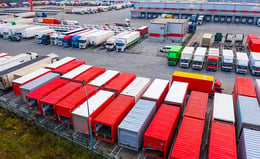How One Forwarder Tapped The Full Potential Of Freight Spot Markets
Keith LaBotz - August 03, 2023

One of Europe's largest and most trusted forwarders, operating a fleet of over 10,000 trucks in multiple countries, wanted to increase growth and profitability with an eco-friendly solution. This forward-thinking company understood optimizing logistics is the key to a leaner, greener business.
Driven by a commitment to excellence and innovation, the company has steadily expanded its operations since its beginnings in 1998. It realized an opportunity to maximize truck utilization across in vast network of partners and agents across Europe, bringing them and flexis AG together on the solution.
Advanced transportation planning would improve fleet utilization and expand the fleet’s capacity. The same technology from flexis could enable the forwarder to engage the transportation spot market more effectively, filling the extra capacity.
The spot market refers to shippers trading “on the spot” when given quotes from multiple forwarders. Approximately half of the company’s freight volume came from contract customers with standing pick-up, and the remainder came from the spot market. Getting new contract customers can take months, even years of sales effort, but this new strategy could boost spot market revenues in a fraction of the time.
However, the innovative forwarder faced several challenges that the solution needed to address before this strategy was possible.
The Challenge
-
Shippers use quote requests, or “load tenders,” in a spot market to determine current market prices, and the most timely, competitive response typically wins the freight. A large fleet can't respond to the immense number of load tenders without software automation.
-
Quicker responses to load tenders were needed to secure more shipments. That would require software capable of building and pricing dynamic loads, effectively managing changes in demand and supply using data from the load tenders. It’s a crucial first step for qualifying potential shipments, let alone calculating costs and a profitable quote.
-
Because vehicles constantly move and capacity may change, the company needed a dynamic planning solution that could evaluate a vehicle's future location and capacity when analyzing a load tender.
-
The forwarder’s massive fleet was comprised of different types of trucks, each with varying operating costs, carbon footprint, and capabilities. Analyzing these attributes is essential for automated truck assignment to shipments from the spot market, but the forwarder lacked the technology.
Customer Requirements
Overcoming these challenges required a solution that would satisfy the following requirements:
-
Seamless Integration: An API for data exchange embeds the solution into existing processes.
-
Improve Fleet Visibility: One control point for optimizing fleet capacity, costs, and demand.
-
Dynamic Vehicle Routing and Scheduling (VRS): Vehicle routing and scheduling adjustments to ensure maximum efficiency and utilization of each truck.
-
Continuous Optimization: Frequent optimization to reflect changing operating conditions and spot market activity.
-
Optimal Vehicle Assignment: Instantly determining the best truck in the fleet for accepting a load tender based on its attributes, current location, future stop, and future capacity.
-
Dynamic Costing: Total landed costs can be calculated for every shipment, so vehicle assignments and responses to load tenders are accurate.
-
Compliance with Regulations: Ensures VRS and transportation planning comply with EU Daily Driving Time and Rest Periods.
The Solution

The flexis solution met the company’s requirements by optimizing logistics with advanced transportation planning and VRS functionality. Employing these capabilities increased fleet capacity and automated management of spot market activity:
-
What-if Simulations: flexis planning applies what-if analysis to hypothetical scenarios to identify optimal strategies, routes, and vehicle assignments.
-
Continuous Move Algorithm: This algorithm looks several steps ahead to determine a vehicle's availability for a new shipment and to ensure maximized truck utilization. This function is vital for accurate quotes and rejecting undesirable load tenders.
-
Dynamic Vehicle Routing and Scheduling (VRS): Intelligent routing and scheduling adjust delivery plans for each truck with demand, capacity, and location changes.
-
Capacity Management: Reserves and allocates cargo capacity while managing load tenders.
-
Collaborative Transportation: Arranging transfers between multiple vehicles complete transportation legs from pickup to final delivery and partnering with multi-modal transportation (e.g., truck, rail, ocean, barge) networks.
The Result
Freight capacity substantially increased through optimization and the ability to accept a broader range of shipments by coordinating multi-leg transportation within the fleet and with third-party networks.
-
Freight demand increased through more effective responses to load tenders and a more agile and intelligent logistics process.
-
The forwarder maximized truck utilization, assigning the most cost-effective, lowest-emission trucks based on vehicle attributes and dynamic variables, significantly improving efficiency and sustainability.
Conclusion
This case serves as a reminder of technology's transformative potential to shift business strategy and create new opportunities. flexis’ advanced planning solutions optimize transportation logistics, allowing fleets to fully tap the potential of spot markets and maximize the utilization of resources.
If you want to learn more get your Guide to Logistics 4.0
In this Guide you will learn:
-
Why a strategic process in transportation planning is a top priority for digitalization
-
What megatrends will increase supply chain volatility
-
How to manage it
LATEST POSTS
- Understand Circular Economy in The Manufacturing Industry
- How Can Industry 4.0 IT Integration Be Achieved Smoothly?
- The Significance of Order Sequencing in Discrete Manufacturing
- How to improve your Supply Chain Management: The Power of Control Towers
- Optimizing Human Resource Scheduling in Manufacturing: A Technological Approach



